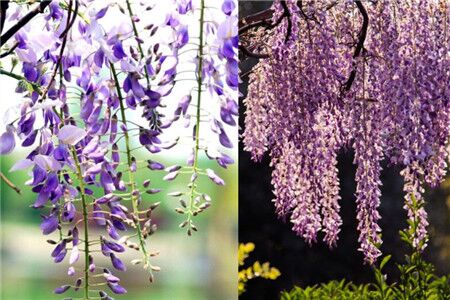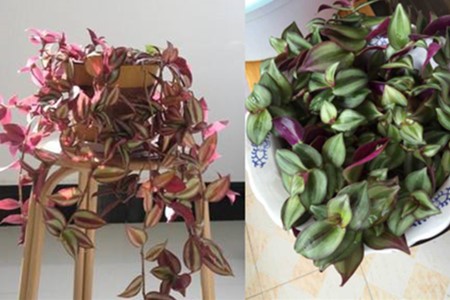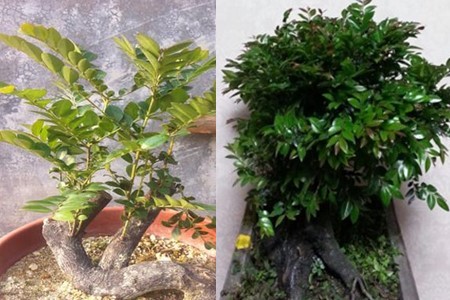The beginners of wisteria need to master several breeding skills.

Speaking of this kind of plant, everyone must have a certain understanding of it. It belongs to a large climbing plant, most of which grow in parks or courtyards, and potted wisteria flowers are rarely seen. And their reproductive ability is very strong, as long as they are planted on the wall, they can grow a lot of green leaves. In addition, they have very good ornamental value, so they are very popular.
When will the wisteria blossom
In general, wisteria flowers bloom from mid-April to late May every year, but their flowering period is very short, lasting about a week. However, the flowering time of wisteria flowers varies with the geographical environment. In the Yangtze River basin, buds usually begin to appear in March and begin to bloom in April.
Wisteria flowers grown in southern China usually bloom in March, while those in the north begin to bloom in May. At the same time, wisteria flowers will blossom again in late summer and early autumn.
When will wisteria flowers be planted
Generally speaking, wisteria flowers are more suitable to be planted in spring. Every spring, wisteria flowers of the race will bloom purple, and the whole plant looks like a pink-purple sea, which makes people linger.
How to plant wisteria and pineapple flowers
1. Soil selection
If you want the plant to grow healthily, it is necessary to choose a suitable pot soil for plant growth. Wisteria likes alkaline and highly permeable soil with loose texture, and should be planted in a windy environment. Plant in a fully enclosed balcony as much as possible, equip the soil and then plant wisteria flowers by pressing or cutting.
2. Temperature regulation
Even if the plant has a very strong vitality, cold resistance and heat tolerance are very good, and its growth rate is relatively fast at about 20 degrees. But when it is below 5 degrees, it stops growing. If the summer is too hot, it will also slow down the growth rate of the plant, so it should be cooled properly at this time, do not put the plant in a strong light environment, otherwise it will easily affect its normal growth.
3. Fertilizer management
Although wisteria is a drought-tolerant plant, it also likes wet soil. So water once a week, each time should be watered thoroughly, need to pay attention to the phenomenon of stagnant water in the flowerpot, otherwise the plant will easily have rotten roots. And wisteria likes to grow in fertile soil, so fertilizers should be applied once a month, choose fertilizers with more uniform nutrients as much as possible, and remember to water them after fertilization.
After the detailed introduction of the editor, everyone must have mastered the skill of planting wisteria. If you want to plant this kind of plant successfully, you need to be more careful and pay more attention in the process of breeding, so that you can see the scene of flowers.
When is the florescence of wisteria pineapple? beginners need to learn these skills.
I believe that many people usually like to plant some flowers and plants, in addition to spending their daily free time, but also edify their temperament. There are many kinds of flowers and plants, one of which is called wisteria flower is very popular, because it has great ornamental value, so many people like to raise it. However, there are still many people do not know when the flowering period of the plant is, and do not know what to do to better cultivate it successfully.
So next, the editor will give you a detailed introduction to the florescence and planting methods of wisteria flowers, hurry up to understand it!
Introduction to the flowering period of wisteria
In general, the flowering time of wisteria is from April to May every year. After blooming, the plant will bear fruit in August. But when it is finished blooming, remember to cut off its remaining flowers, otherwise they will compete for nutrients from each other, thus seriously affecting the growth of wisteria.
Introduction to the growth environment of wisteria
If you want to know how a plant is cultivated, you need to know what kind of environment it likes to grow in. Wisteria is very adaptable and hardy, so it can survive the winter in most parts of China. And the plant likes to grow in a sunny environment, and the requirements for the soil are relatively simple, and it can grow normally in fertile, loose and deep soil. And the main root of wisteria is longer, and the lateral root is less, so it can easily adapt to the urban environment.
3. Cultivation of wisteria
The cultivation methods of the plant are also varied, including cutting, sowing, striping and ramet. Because of its deep taproot and few lateral roots, it is not suitable for transplanting. After each collection, the seeds should be dried and stored, and the seeds should be soaked for 12 hours before sowing, and the seeds can be sowed and raised in the seedbed in the open field. The Beginning of Autumn can grow seedlings moderately in the future, and he can come out of the nursery after three years. If the seedlings are moved, it is recommended to bring soil balls.
If you want to cultivate the plant, you can also choose in early spring, choose 1-year-old strong branches cut into 15-20 cm segments as cuttings, dozens of them can be trapped in a bundle, buried first in the leeward and sunny wet zone. The branches are covered with soil for ten centimeters, and then the plastic film is improved to achieve the purpose of heat preservation and moisture preservation.
It can be dug up for cuttage in early May, and the survival rate of this breeding method is very high, and the speed of seedling formation is also relatively block. In addition, ramet propagation can also be carried out and cultivation can be started in spring and winter.
How to preserve wisteria pineapple
1. Watering
Because the main root of the plant is very deep, it has a very strong ability to resist drought. However, wisteria still like wet soil, but usually do not overwater, resulting in root soaking in water, easy to cause the consequences of rotting roots.
2. Fertilization
In general, wisteria only needs to apply compound fertilizer 2-3 times a year to meet its growth needs. A little nitrogen fertilizer, calcium superphosphate and so on can be applied before its germination, and additional fertilizer is needed for 2-3 times during its growth period.
3. Pruning
If you want to prune wisteria, you should choose during the dormant period of the plant. When pruning, the branches can be evenly distributed by densification and artificial traction. In order to promote the flourishing of flowers and leaves, it is suggested that we should prune reasonably according to the activity of the plant.
How to raise wisteria bonsai and teach you how to do it easily in six steps
Wisteria is named for its color and shape. It has high ornamental value and is loved by many friends. I heard a lot of people praise it before. After seeing the wisteria bonsai, I also became a person who loved it. So, how on earth should wisteria bonsai be kept? Next, let me share with you the culture method of wisteria bonsai.
It is very important to select seedlings for planting wisteria bonsai. In fact, if you choose seedlings, you can take any method, but in most families, bonsai seedlings are purchased directly from the florist, so the survival rate will be higher. But there are also a small number of "experts" who like to cultivate from the seeds.
First, Miao Yuan.
The methods of sowing and cutting propagation can be carried out. Sowing time can be in early spring, the temperature is required to be between 10 ℃ and 13 ℃. If it is cutting propagation, it can be carried out in autumn.
Second, making wisteria bonsai.
1. Put on the basin.
It is better to plant in spring, that is, February-March. Pot soil we should use more fertile, good drainage of rotten leaf soil and soil mixed. Good flowers should be made in pots. We can choose some deeper, more atmospheric-looking basins, which can be angular or circular in shape.
2. Modeling.
We give priority to pruning and finishing, followed by binding, the purpose of which is to fully express the simple and beautiful natural form of plants. When pruning, the branches should be scattered in order to avoid monotony, but not too many layers. We see a variety of wisteria bonsai forms. In this respect, you can use your imagination and make a good-looking look.
3. Watering.
We will find that it consumes a lot of water, but even so we can't water it often. If it is only wet but not dry, it is not conducive to flowering. When it comes to watering, don't water it until it's dry. Water must be thoroughly watered. Especially in August, there should be less watering. Normal watering can be carried out in September.
4. Fertilization.
The frequent application of thin fertilizer is a key point to make wisteria blossom and blossom, so remember. During the growing period of the plant, we can water it according to the situation, and we can put the cake fertilizer with relatively low concentration every half a month. We don't stop fertilizing until July-August, and we have to continue to apply fertilizer in September. However, the frequency and concentration should be reduced appropriately. Before flowering, we can appropriately increase the number of times of phosphorus and potassium fertilizer application depending on the situation.
5. Pruning.
When wisteria sprouts in spring, it is necessary to pick the shoots properly. When the new branch grows to more than 20 centimeters, we can cut off the overlong new branch. September is the period when the old leaves of wisteria are easy to age and droop, because it will affect their appearance, so we can pick off the old leaves to speed up the germination of new leaves. The germinated new leaves are relatively tender, which can effectively postpone the defoliation period and prolong the viewing period of bonsai.
6. Turn the basin.
It would be better to turn the basin before the sprouting of early spring. After that, you can turn the basin every two or three years.
Third, pest control.
Compared with other flower plants, wisteria has fewer pests. But pests are everywhere, and aphids and leaf moths are the pests of wisteria. Our prevention and control method is mainly to spray trichlorfon and emulsified dimethoate and other insecticides.
These are all I have shared about growing wisteria bonsai. Is there anything I can do to help you after watching it?
- Prev

We must pay attention to how to raise Violet orchids.
Violet hanging orchid is a very beautiful hanging orchid, now many people like to raise hanging orchid, it is a good choice, raising such a pot of hanging orchid will make your house have the breath of life.
- Next

A few tips for raising red sandalwood bonsai in the sun
Lobular rosewood, mainly from India, in addition to ornamental plants, it also has the effect of beauty, regular contact with lobular rosewood is conducive to health. But can this plant be sunburned? The next small series introduces you in detail
Related
- Fuxing push coffee new agricultural production and marketing class: lack of small-scale processing plants
- Jujube rice field leisure farm deep ploughing Yilan for five years to create a space for organic food and play
- Nongyu Farm-A trial of organic papaya for brave women with advanced technology
- Four points for attention in the prevention and control of diseases and insect pests of edible fungi
- How to add nutrient solution to Edible Fungi
- Is there any good way to control edible fungus mites?
- Open Inoculation Technology of Edible Fungi
- Is there any clever way to use fertilizer for edible fungus in winter?
- What agents are used to kill the pathogens of edible fungi in the mushroom shed?
- Rapid drying of Edible Fungi

